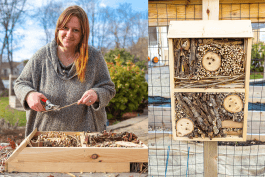
The success of our gardens is owed in huge part to the pollinators and predator bugs that inhabit the area. Some estimates say that one in every three bites of food we eat needs pollination by bees, butterflies, birds, bats, beetles, and other insects.
One of the ways gardeners like to encourage pollinators to spend more time near their gardens is by planting brightly-colored flowers and building a bug hotel, motel, or even just a small bug house.
We have had a small bug house in our yard for some time that we built from a birdhouse frame, but I was very excited to expand and build a much bigger bug hotel, and I learned a lot along the way. If this is your first try, I highly recommend starting small. It takes an incredible amount of material to fill a large “hotel”.
I also recommend this as a spring project, because you’ll find that all the leftover brush from last year’s flower gardens, sticks in your yard, and old dry pinecones make excellent materials.
Hollow stems and branches are perfect places for bugs to enjoy, although they’re just as happy with the cracks between logs and sticks.
Let’s start with a few examples of a bug hotel so you know what aiming for, aesthetically speaking.
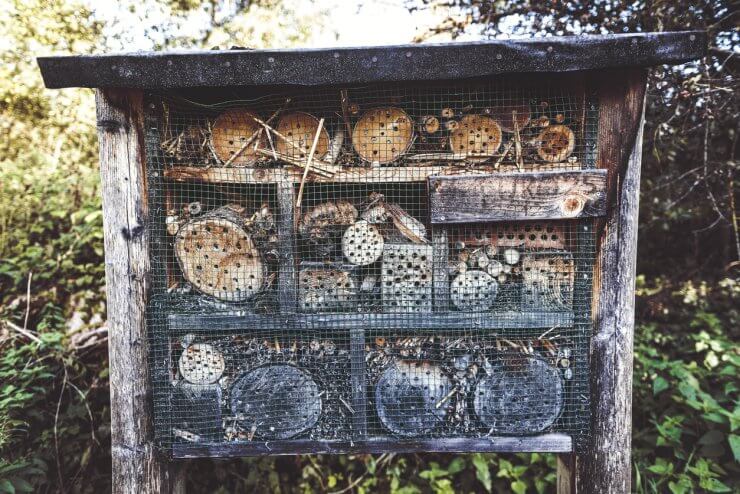
Above is an example of a very simple but large bug hotel. You’ll see a few necessary elements that all bug hotels should ideally include:
- An overhang to prevent excess water from getting in
- 1/8″ to 1/2″ holes drilled in logs to provide shelter for mason bees and other pollinators
- Sticks, reeds, and other debris to fill in the gaps, which the bugs will enjoy sorting through as well.
- Optional: Mesh screen to prevent materials from falling out.
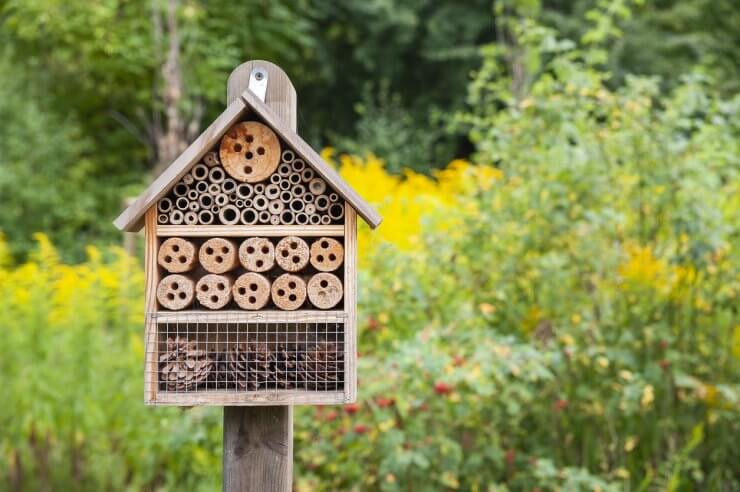
Here is another example of a more simple, possibly even commercially produced bug hotel. You’ll notice it’s mostly comprised of:
- Drilled logs for the mason bees and other pollinators
- Hollowed out or simple hollow stems and sticks like bamboo or reeds
- Shelves to keep different materials in place
- Pinecones covered by a screen to prevent them from falling out

Not all bug houses need to be perfect though, and in fact they rarely are! This example doesn’t need to be hung at all, instead, it’s made up of many different compartments that couldn’t otherwise be used in a smaller tree-hung bug hotel, such as:
- bricks that provide additional holes for all sizes of creatures
- clay pots
- hay and grass
- leaves
- paper
My only concern with a bug hotel like this so close to the ground is that you may also attract slugs, and pests you don’t want. However, you’ll certainly attract beneficial ground-dwelling insects like centipedes. Perhaps giving the slugs a place to go, away from your garden is the strategy here!
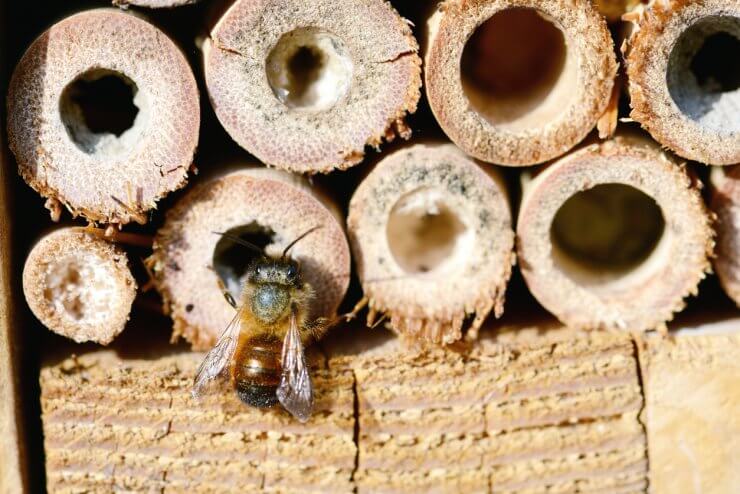
The benefits of bug hotels
Pollinators are going to come to your garden regardless, and especially so if you’re surrounding it with beneficial companion plants and trap crops like marigolds. So do I know if bug hotels really work to attract even more?
I don’t speak the language of the bees, but giving them an easy place to live and relax will certainly help, won’t it? Here are a few proven benefits:
- Increase the biodiversity in yards that are heavily landscaped
- Reduce the need for pesticides, in exchange for biological pest control
- Add a natural habitat, when so much is being lost every day
- Give kids a way to understand how to balance an ecosystem
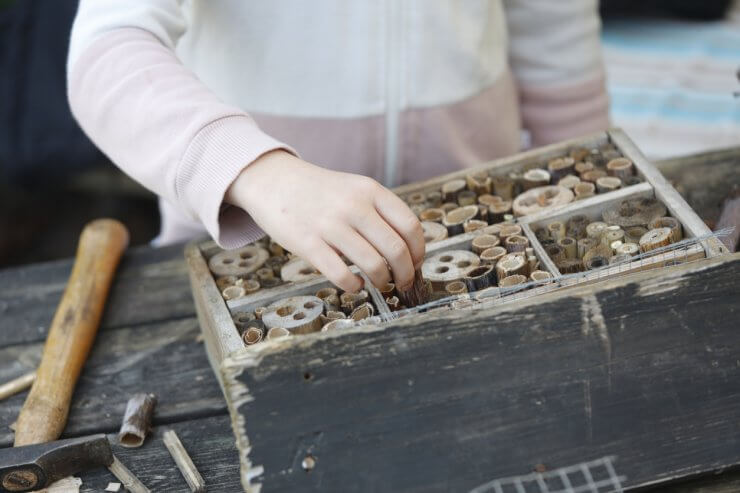
And while we all know bees are a huge help, and the declining bee population is a mission we should all be taking on, did you know that beetles were the first pollinators, more than a hundred million years ago? They pollinate 88% of flowering plants, even more than bees! Other types of pollinators that bug hotels can attract include hummingbirds, bats (yes some bats pollinate too!), butterflies, green lacewings, and more.
In terms of building a bug hotel, keep a few materials in mind:
- Holes in wood, and the inside of bamboo and reeds will attract single bees and wasps that will lay their eggs. Holes that are 1/8″ – 1/2″ are best.
- Rotting bark and damp places are beloved by centipedes.
- Rotting logs are sought out by wood-boring beetles.
- Cardboard tubes and egg cartons make great spaces for bigger flying insects, as do pine cones, twigs, hay, and other garden materials.
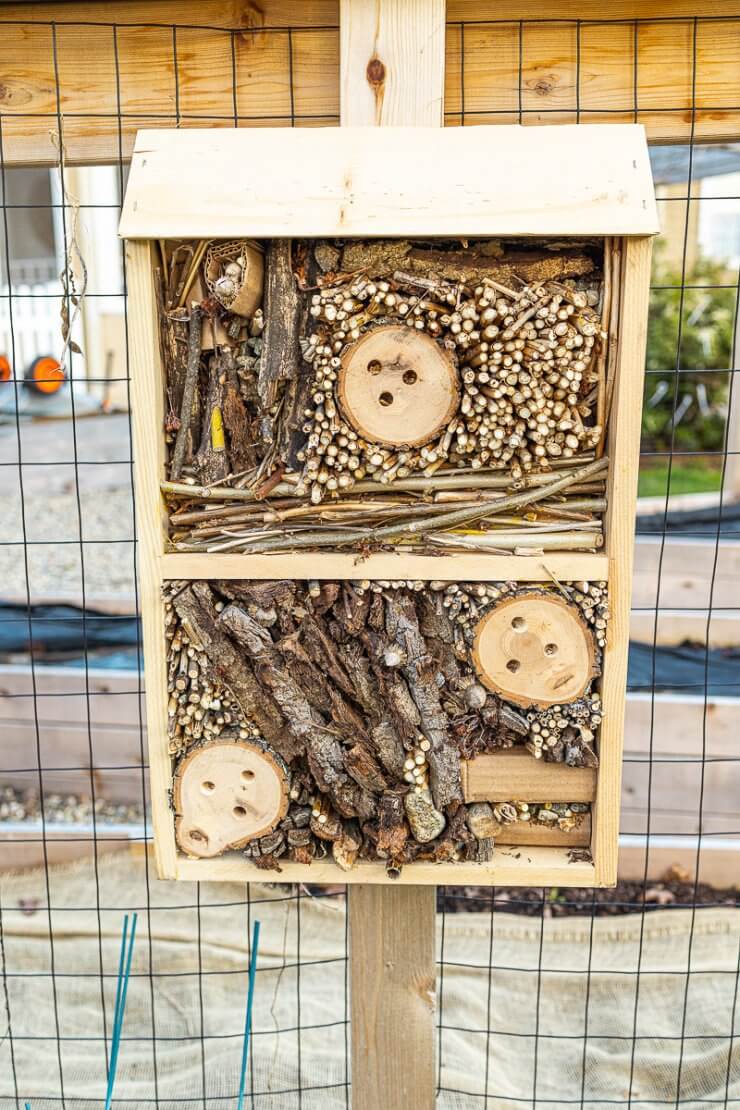 How to build a DIY bug hotel
How to build a DIY bug hotel
It’s hard to say exactly “how” to build a bug hotel, but I’ll offer some general guidance on the materials you need, and how to sort them.
- Find yourself a container. I found mine in the beekeeping section of my local farmer’s co-op. Ideally, your bug hotel should have a little overhang to prevent it from getting too soaked during the rain, but otherwise, the dimensions, size, and style are up to you. You could use an old dresser drawer, an old shelf, a shadow box, or even a birdhouse with the front part removed. Or, you can build one from scratch using some of the examples above as your mentors. Having shelves and platforms for items to rest on will make it less stressful to fill tightly. Having a back on it will keep everything from falling out.
- Gather materials. You’ll want logs, sticks, reeds, bamboo, bark, stones, pinecones, and cardboard. Wood glue can also be helpful.
- Cut materials to interior depth. I personally found this impossible to keep perfect because you’re cutting so many materials of different shapes and sizes, but in an ideal world, all the cut pieces will be the same height as your container is deep, or slightly shorter.
- Start filling! Now you just need to lay the container down and start filling. trying to fill it while upright can be a bit taxing, so I found laying it down to be a lot easier to get everything settled and tight without worrying about items falling out.
- Optional: Use wood glue. If you have a lot of smaller pieces, squeezing some wood glue in the cracks can be helpful in the long term. And to cover it so it’s not so obvious, just sprinkle some of the scraps from your cuttings over the top to cover the glue.
- Optional (add wire or mesh). If you’re adding a wire layer to keep items in, tack it to the front now.

Will you build a bug hotel?
I think you should! It’s a bit of an art form really. I think with a lot of patience and time, you could build something really lovely, but the nice thing is that no matter your skill level, you can always start small and build from there!
Let me know if you have any questions about building a bug hotel!


 Previous
Previous


I built my bug hotel and it’s very cool, Wish I could send a picture of it. We had a lot of fun making it.
What about placement in your yard/garden? How close does the hotel need to be? Or can it be built and hung in close proximity like the garden shed?
I have mine hanging directly on my garden trellis so that it’ll be close to the plants. But, having a flower garden across the yard will still attract bugs to a vegetable garden on the opposite side, so I think anywhere nearby would be useful.